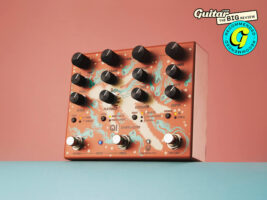
Walrus Audio Qi Etherealizer review – chorus, delay, reverb and glitchy ambient soundscapes all in one pedal
$449/£445, walrusaudio.com
It’s quite possible that people will come to know the Walrus Audio Qi Etherealizer as ‘the Yvette Young pedal’. Especially people who don’t know how to pronounce ‘Qi’. But let’s make one thing clear: this is not an artist signature product.
READ MORE: DigiTech HammerOn review – will this ‘instantaneous pitch shifter’ hit the nail on the head for enhanced creative playing?
With her band Covet, Young has become known for her intricately melodic and fluid playing, high on clarity and low on atmospheric excesses. Which means the Qi – combining chorus, delay and reverb with grain-based glitch effects and epic stereo soundscaping – is pretty much the opposite of anything you might call her signature sound.
Okay, so let’s just go along with Walrus and call it a ‘collaborative creation’. But that still leaves the question of why the Yvette Young pedal doesn’t sound like, well Yvette Young?
Image: Adam Gasson
Walrus Audio Qi Etherealizer – what is it?
The best person to explain this contradiction is surely Young herself – which she did back in January when m’colleague Josh Gardner collared her at the NAMM Show, where the Qi (it’s pronounced ‘chee’, by the way!) was launched.
“My overall vision for the pedal was to have something that was an idea generator, an instant vibe,” she said. “I’ve been doing a lot more producing and film-scoring stuff, so I got interested in abstraction. As guitar players, I think we all go through things where it’s like, ‘Oh well, I have my style, I play my riffs…’ I needed something that pushed me and challenged me creatively. And I feel like the granular stuff pushes me in an abstract direction and makes me think in a more painterly way with sound.”
It’s not all about leftfield larks: the reverb and chorus are straightforward enough, while the delay is a simple digital type with no modulation or filtering. But the grain effect is properly radical; there are multiple options for holding down a footswitch to create sustaining beds of sound, and all of this happens in full stereo. Technical math-rockers, brace yourselves: things are about to get bigly ambient.
Tell you what, though… this pedal comes in two finishes: plain black, and a sort of fudgy hue with what appears to be a freshly electrocuted corpse on it. Seeing as Young’s two signature Ibanez guitars come in vibrantly sparkly green or orange, I think we’re allowed to be a teeny bit disappointed with those options.
Image: Adam Gasson
Walrus Audio Qi Etherealizer – in use
First of all, is it easy to turn the individual effects on and off with your feet? No, it is not. In fact it’s virtually impossible – holding down a little push-button is the only option for manual bypass – so bear that in mind if you were thinking of using the Qi as a conventional multi-effects stomper. Actually, there’s so much twiddlability in this 12-knob unit that, unless you enjoy playing the guitar while hunched over like William Blake’s Newton, you might want to consider popping it up on a desk.
And what are those 12 knobs? They’re best understood as four separate columns, each controlling one effect. So, starting on the right, the chorus has mix, rate and depth then the aforementioned push-button, which also lets you switch between tri-chorus and stereo modes; the delay has mix, time and feedback then three time-division options on the button; and the grain has mix, ‘X’ (basically the length of the chopped-up sound slices) and a five-way switch for playback speed, while the button flips between two modes: ‘grain cloud’ (for short glitchy repeats) and ‘phrase sample’ (for longer randomised loop effects).
Same kind of deal with the reverb, then? Not quite – the left column has just a single ‘space’ control for that, and the others are for the pedal’s overall output: wet/dry mix, wet tone, and a button for series or parallel routing.
Now we come to the footswitches… and it’s good news for people with three legs, because there’s a lot going on here. On the left is the master bypass switch, but you can also hit this and the middle one together to scroll through three presets plus manual mode. The right switch is for tap tempo but you can also hold it down to ramp up the delay to maximum feedback; hold down the centre switch to do the same with the reverb, or bop it once to freeze the grain effect.
Can you have the delay, reverb and grain all maxed out at once? Yes. Does this sound vast, spectacular, mystical, magical and potentially hallucinogenic? Also yes. But that’s far from the whole story.
Image: Adam Gasson
Walrus Audio Qi Etherealizer – sounds
You know when you buy a digital pedal and it comes with 200 presets and 196 of them sound like crap? When I am World King, this will be banned. Or maybe just tariffed at 75 per cent, I haven’t decided yet. Anyway, it won’t be a problem for the Qi, because there are only three factory presets (created by Young herself) and they cover the basics very well.
So that’s probably a good place to get started if you’re new to this sort of thing, but for the purposes of this review the first step is to jump straight into manual mode – helpfully indicated by a white LED – for a methodical exploration of each effect.
The chorus gets things off to an extremely promising start, with a sweetly wobbly core sound and lots of flexibility from those three knobs as well as the welcome bonus of the mode button. The stereo effect is suitably luscious, but in a mono setup you might just find the tri-chorus more appealing.
The delay hardly needs discussing, as it’s completely straight and unfiltered unless you choose to attack it with the master tone control – more on that in a sec – while the grain effect is suspiciously similar to the new algorithm on the Walrus Mako Series MkII D1 delay, with the same five options: standard, octave up, octave down, reverse and random (which hops freely between the other four). As on the D1, it’s all quirky but clean and loads of fun.
Finally, the reverb leans towards hugeness and has a tendency to eat everything you put in front of it – even at halfway it will mush out fairly strong delay repeats. Well, this is an ‘Etherealizer’ after all… even so, in the name of balance it’s good to have the parallel option, whereby the four effects are processed separately then summed together at the end.
Image: Adam Gasson
But the best part of this section of the Qi is the tone knob. It might not look like much, but this is a synth-style resonant low-pass filter with a whole lot of sound-shaping muscle. It’s best left fully open to start with, then yanked down for dramatic shifts in and out of darkness – particularly effective when you want to add some movement to an endlessly looping ambience. Speaking of which… let’s start freezing stuff.
Hold down the tap footswitch and the delay takes a few seconds to properly snowball, which it does in a nicely saturated way; it won’t soar and swoop like an analogue type when you start messing with the time knob, but it will make some interesting thwocky noises.
Freezing the grain has a quite different effect, instantly creating a hypnotic loop of pure texture, while maxing out the reverb takes the edge off the granular glitching and turns that loop into a galaxy-sized stereo wash. As a shortcut to ambient nirvana it feels, if anything, too easy – am I still a musician here, or just the pedal’s supervisor? – but where the Qi really excels is in the freedom it gives you to set up a bed of sound and then play around with it.
I mentioned the power of the tone knob earlier; you can also change the grain speed (try going from double to reverse then back again!) and even flip between ‘cloud’ and ‘sample’ modes. Every move adds a new evolution to the soundscape, and brings the kind of unpredictability that might just save you from pseudo-spiritual self-indulgence.
Image: Adam Gasson
Walrus Audio Qi Etherealizer – should I buy it?
In the nicest possible way, this feels more like a toy than a tool. Set up in stereo with a good pair of amps, or a two-channel preamp and headphones, it will eat up whole days of your life as you find yourself creating magical realms of rolling sonic wonder just by picking a few notes and tweaking a few knobs. I don’t think I’ve ever come across a pedal that does this so well, especially in terms of the ability to modify and layer soundscapes once they’re already in flight.
The only caveat, of course, is whether anyone else will ever want to hear these semi-automated creations. I think the answer to that comes down to how you use the Qi – that is, preferably in moderation. The four effects all sound great in normal operating mode, so there’s plenty to explore here without always jumping straight into lushness overload. Please bliss out responsibly.
Walrus Audio Qi Etherealizer alternatives
Is this a multi-effects pedal or an ambient soundscape generator? It’s somewhere between the two, in a zone where you’ll also find the Hologram Chroma Console ($399). For pure brain-swamping reverb you won’t find better than the Old Blood Noise Endeavors Dark Star Stereo ($299/£299).
The post Walrus Audio Qi Etherealizer review – chorus, delay, reverb and glitchy ambient soundscapes all in one pedal appeared first on Guitar.com | All Things Guitar.
Source: www.guitar-bass.net











